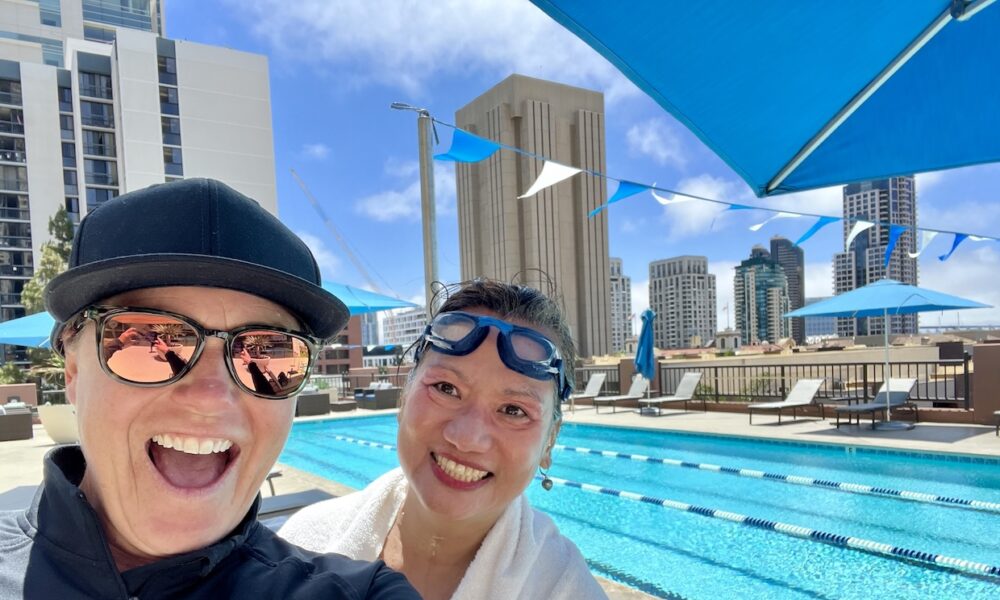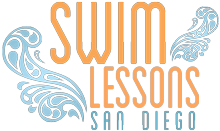A lot of adults want to learn how to swim, especially in San Diego. In my experience I’ve seen the same misinterpretations about adult swim lessons. To better prepare you for starting swim lessons I’d like to clear up these misunderstandings and set you up for success.
1. Learning to swim is easy for kids.
Many adults assume that learning to swim as a child is easier and that they’ve missed out. I agree it’s different, but not necessarily easier. Children usually take frequent swimming lessons year after year and are given ample opportunities to play in the water and to try on new skills. Some adults who want to learn how to swim don’t realize 5-10 swimming lessons is not enough, especially if they are uncomfortable in the water. They often neglect the reason kids learn so quickly: practice time to feel comfortable in the water and repetition of new skills so they stick.
2. I just need to learn how to tread water to be safe in deep water.
Treading water is important, but exhausting! Floating on your back is the most important life saving skill. Plus, if treading is all you know, how would you be able to swim to safety? You need three skills to safely swim in deep water: you need to know how to swim on your front with breathing, how to tread water and how to float on your back. Learning to swim and to be comfortable in these three different positions takes time and practice. Then there’s putting it all together! Applying these skills in deep water might look like swimming on your front, treading water to stop and take a break or to look around, and floating on your back to rest if you get tired. The goal is to be able to do these transitions automatically to avoid panic. When our bodies go into a panic state we sink like a rock because of shallow breathing and muscle tension. Then we tire ourselves out fighting the sinking feeling and fear. To stay high in the water we need our lungs full like a fully inflated raft and our muscles relaxed. Knowing when and how to use all of these skills makes for a confident, relaxed swimmer who knows how to make life saving water safety decisions.
3. If I hurry I’ll get to the other end.
Beginner swimmers often rush, which is a sign of not yet being comfortable and relaxed in the water. It doesn’t matter how long it takes you to get there if you are in control of your body position, balance and breathing. When you relax swimming feels easier. When you rush to get there, you’re going to get more tired, more out of breath and more panicked. You won’t get very far before you have to stop and rest. Learning to relax in the water and take your time takes a lot of practice. Getting comfortable in the water is one of the most important swimming skills that allows you to be a strong swimmer.
4. If I try to swim faster, I’ll get there faster.
Half of swimming faster is moving through the water with less drag or resistance. Most beginner swimmers don’t know how to do that. A big part of learning how to swim is finding the path of least resistance and using the water to your advantage to glide through it. Swimming is not like running where you can just push yourself to go faster. Water is over 800 times more dense than air. Fighting it is a losing battle that will only wear you out.
5. Lessons once a week is enough.
If you have a fear of the water it’s likely that taking adult swimming lessons once a week will not be enough, especially if you are uncomfortable practicing on your own. Waiting a week to get back in the water will often make you feel anxious and you’ll spend much of the time getting comfortable all over again which leads to frustration and diminishes the value of the lessons. To keep your motivation high you need to feel progress. To do so you need to feel more comfortable in the water and see yourself mastering new skills. Taking adult swim lessons more frequently upfront then backing off to lessons less often is a great way to offer yourself some extra support until you feel confident enough to practice on your own and have an idea of what you’re doing. To get better at swimming you ideally want to swim 4-5 days a week. Making progress gives you a sense of accomplishment, incentive to stay committed to learning how to swim and gives you a higher chance of reaching your goals.

